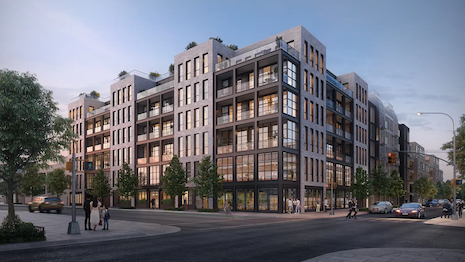 Condos and apartments are poised for a meteoric rise in 2023. Image credit: Compass
Condos and apartments are poised for a meteoric rise in 2023. Image credit: Compass
Real estate professionals are preparing for a major metropolitan comeback in 2023.
Market predictions are captured as part of a new real estate forecast report, out now. Nearly 60 percent agreed somewhat or strongly with the sentiment that as affordability challenges continue, COVID-19 fades and companies require a return to the office, condos will experience a resurgence in popularity next year as cities regain their luster.
“This rings true,” said Fouad Talout, founder and president of Talout International, McLean.
“City living has always had certain advantages and appeal,” Mr. Talout said. “Plus, people's collective memory is short — COVID will be forgotten and it will return to business as usual.”
Market shifts
The upcoming year will be marked by the growing market power of buyers, according to the top real estate entities and agents brokering these deals.
Besides the shift from a seller’s to a buyer’s market, industry professionals foresee housing market conditions reaching a state of equilibrium over the next 12 months.
About 71 percent predict housing inventory to remain at current levels or increase somewhat.
Roughly 3 in every 4 respondents shared expectations for rent to remain at current levels of increase somewhat as well, based on anticipated demand.
As Compass’ survey shows 44 percent more survey respondents foresee urban living growing in popularity in 2023 relative to 2022, as compared to the segment that sees urban living fading in popularity. The number of respondents who see large yards fading into obscurity, in fact, was 49.1 percent higher than those opposing.
Thus, condos and apartments are poised for a meteoric rise following the years of urban flight resulting from the global health crisis.
Mr. Talout, an expert in luxury real estate dealings — his eponymous top DMV-area brokerage specializes in selling elegant estates and fine properties — confirms early signs of this metropolitan migration wave.
“Other factors that will contribute are convenience, location, mobility and community,” he said.
View this post on Instagram
Speaking of, a deeper dive into buyer demands for these spaces reveals a prioritization for shared community amenities.
The number of real estate agents who cited facilities like community centers, pools and tennis/pickleball courts picking up in popularity amounted to more than triple the number of those who claimed these offerings would decline in appeal.
“People everywhere need to buy and sell homes every day, and these buyers and sellers will show up to compete throughout 2023 and beyond, as the market continues to rebalance and normalize,” said Leonard Steinberg, president of Compass, in a statement.
“In a world that’s in the midst of an energy crisis, smaller, more-efficient living will grow in appeal across all segments — from entry-level to ultra-luxury.”
For the release, Compass designed, fielded and analyzed results from 443 agents online between Dec. 5, 2022, and Dec. 16, 2022, nationwide. All forecasts, views and statements included are based on the results of the “Annual Agent Market Forecast” survey.
Journey home
Of all survey results, a resounding faith in one’s own neighborhood is particularly striking: as compared to national market performance next year, respondents tended to express an outspoken optimism regarding the impending strength of local sales.
For instance, 22.5 percent predict sales volume in their local area to grow in 2023 from 2022, versus 15.9 percent who see the same trend happening nationwide. What is more, 68.5 percent expect local prices to stay at current levels or grow, while 79.6 percent forecast national home prices will plateau or fall.
View this post on Instagram
New York City is one example locality where buyer interest appears to be on an upward trajectory.
A 2021 report cites that as people’s long-term rentals expired and a sense of ‘normalcy’ returned alongside seasonal transitions, agents saw city residencies bounce back. Per a Q2 Manhattan market release (see story), condo sales in the city reflected a 4.8 percent increase year-over-year, while co-ops recorded a 10.8 percent increase for the same time period.
Despite much debate regarding its post-pandemic state, previously reported results and new expert insights alike align with its latest musings on the future popularity of city living.
“Definitely agree that the local market can vary considerably from the national market,” Mr. Talout said.
“The return to work at the office is not the only factor [driving demand],” he said. “Other considerations include inventory, interest rate, and the economy in general.”
“In the metro D.C. area, for example, prices will stay the same or — more likely — go up, largely due to continuing low inventory of homes for sale versus high buyer demand.”